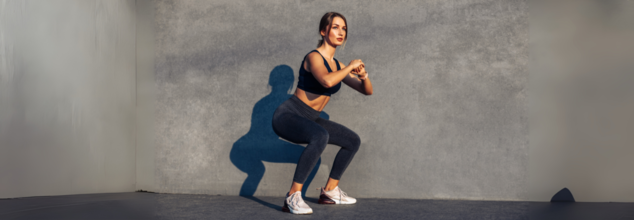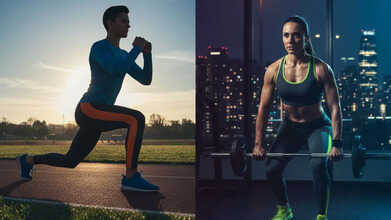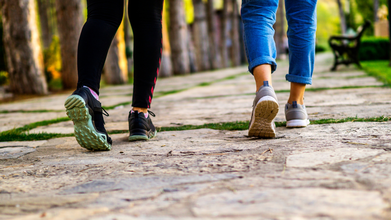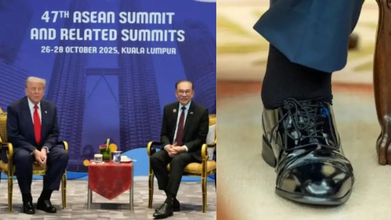- Health Conditions A-Z
- Health & Wellness
- Nutrition
- Fitness
- Health News
- Ayurveda
- Videos
- Medicine A-Z
- Parenting
- Web Stories
Is Your Squat Count At Gym A Warning Sign For Your Health?

Credits: Canva
When one hears the words "health check," a doctor's appointment or blood test might be the first images that spring to mind. But we have a surprise for you: your capacity or lack thereof to do a simple squat can tell you just as much about long-term health and physical independence as either of these.
As the top fitness experts say, your squat number isn't merely a measure of gym performance—it may be a red flag that your body isn't performing at its optimal level. This apparently simple movement is really a potent diagnostic tool for mobility, muscular strength, and functional health at every stage of life.
Squats are one of the most fundamental movement patterns in the human body. Whether you’re getting in and out of a car, picking up your child, or simply sitting down, you’re performing a variation of a squat. And that makes this movement more than just a gym staple—it’s a daily necessity.
"Squats replicate fundamental human movements," says one personal trainer. "They work multiple muscle groups, assist in keeping joints mobile, and are critical to functional tasks of daily living."
And yet, simple as they are, squats can be telling. Being unable to complete a given number of reps, or unable to achieve proper depth without sacrificing form, may be indicative of deeper problems—weak ankles and tight hips, poor balance, and mobility restrictions.
How Many Squats Should You Be Able to Do?
Exercise professionals have defined a series of age-related standards to determine if your squat performance is within a healthy range. These standards consider the normal changes our bodies experience as we age, but still challenge us to be strong and functional.
Here's what optimal squat capacity looks like by age:
In your 20s: 50 bodyweight squats continuously or 10 squats with 40–50% of your body weight
30s to 40s: 50 bodyweight squats or 10 squats with 50–60% of your body weight
In your 50s: 40 bodyweight squats or 10 squats with 40–50% of your body weight
60s: 30 bodyweight squats or 10 squats with 30% of your body weight
70s and beyond: 20 squats using bodyweight or 10 squats with 20% body weight
If you're not meeting these goals, it may not be a matter of fitness at all—it may be a sign of something more serious underlying your physical resilience.
Before reaching for the numbers, experts recommend starting with form first. Good squat mechanics save your joints, activate the correct muscle groups, and seriously limit the potential for injury.
Some of the most important form checks are:
- Keep your heels firmly on the ground
- Align your knees with your toes, keeping them from collapsing inward
- Hinge at the hips with your chest kept up
- Lower only as low as you can keep good form, ideally to 90 degrees
Bodyweight squats are great for beginners or as a warm-up, but progress tends to plateau because of insufficient resistance. That is where weighted squats enter the picture—using dumbbells, kettlebells, or barbells increases muscle activation and develops strength more quickly.
Why Muscle Matters—At Every Age
It's a myth that getting older automatically leads to physical deterioration. Lifestyle behaviors and chronic inactivity contribute more to loss of mobility and injury risk than your birthdate.
Sustaining muscle mass through functional exercises such as squats promotes:
- Enhanced balance and coordination
- Higher bone density, minimizing the risk of osteoporosis
- Lower risk of falls and fractures, particularly in the elderly
- Improved metabolic health, assisting with weight management and energy levels
- Greater cardiovascular health and longevity
- Strong muscles also serve as shock absorbers for your joints, minimizing wear and tear on your hips, knees, and lower back.
What Muscles Do Squats Target?
Squats are a compound exercise that engages multiple muscle groups at the same time:
Primary movers: Gluteus maximus (butt), quadriceps (front thighs), and soleus (deep calf muscle)
Assistants: Hamstrings, calves, and muscles of the inner thigh
Stabilizers: Core muscles, including abdominals and spinal erectors
This full-body engagement is why squats are a non-negotiable in any well-rounded fitness program.
How to Improve Your Squat Safely?
If you’re struggling with your squat form or numbers, it may be due to limited ankle or hip mobility, weak glutes, or tight hamstrings. The good news? All of these are improvable with targeted mobility work and strength training. Here’s how to perform a proper squat:
- Stand with feet shoulder-width apart, toes turned slightly outward.
- Maintain your chest up, and slowly lower your hips as if sitting down in a chair.
- Make sure your knees track over your toes, not collapsing inward.
- Get as low as you can without compromising form—preferably until thighs are parallel to the ground.
- Push through heels to return to standing.
Consistency is everything. Begin with bodyweight squats, and gradually add volume and resistance as you develop strength.
Squats are more than a fitness benchmark—they're a reflection of your body's strength, balance, and longevity potential. Reaching your age-specific squat count isn't about reaching arbitrary numbers. It's about having your body ready for life, from daily tasks to long-term independence.
Morning vs Night Workouts: What Experts Say About the Best Time to Exercise

Credits: GEMINI
If you have made exercise a regular part of your life, you have probably wondered when the ideal time to work out really is. Should you lace up your shoes first thing in the morning, hit the gym after work, or mix it up depending on your schedule?
According to the American Heart Association, adults should aim for at least 150 minutes of moderate aerobic exercise or 75 minutes of vigorous activity each week, ideally split across several days. Adding resistance or strength training three times a week can provide even greater benefits. But what do fitness experts say about the best time to get moving?
Should I Work Out in the Morning or at Night?
Both morning and evening workouts come with their own advantages, but what matters most is consistency. The best workout time is simply the one that fits into your daily routine and keeps you moving regularly.
The Centers for Disease Control and Prevention (CDC) also recommends getting 150 minutes of aerobic exercise per week—activities like brisk walking, cycling, or jogging all count. It’s more effective to work out four evenings a week than to squeeze in only two early morning sessions.
Working Out in the Morning
Exercising early has a clear advantage, you can get it done before the rest of the day begins. Research also suggests that morning workouts can improve sleep patterns, regulate mood, and even support weight management.
Boosts Your Mood
Exercise releases endorphins, the body’s natural “feel-good” chemicals. Studies show that even short sessions of regular physical activity can lift your mood and lower cortisol, the stress hormone. Starting the day with lower stress levels can help you feel more focused and positive throughout the day.
Improves Sleep Quality
Morning exercisers often enjoy deeper, more restful sleep. One study found that those who worked out early tended to fall asleep faster, spend more time in deep sleep, and wake up less during the night.
May Lower Blood Pressure
Morning workouts can help stabilize blood pressure, particularly in women. Research suggests that women who exercised early in the day experienced lower post-exercise blood pressure, while men saw similar results when exercising in the afternoon.
Might Help You Lose Weight
Timing might play a role in how your body responds to exercise. One study found that people who worked out before noon lost more weight than those who exercised later in the day. Early exercisers were also more active overall, taking more daily steps. However, more research is needed to confirm these findings.
Downsides Of Morning Workout
Despite the perks, morning workouts aren’t without drawbacks:
- Higher injury risk: Your body temperature is lowest right after waking up, which means less blood flow and muscle flexibility. This can increase your risk of strains or sprains. A proper warm-up can help prevent this.
- Low energy: Exercising on an empty stomach can make you feel weak or tired. Eating a small, protein-rich snack the night before or before your workout can help.
Working Out in the Afternoon or at Night
While early workouts offer plenty of advantages, exercising later in the day has its own set of benefits that may suit your body and lifestyle better.
Benefits Of Working Out in the Afternoon or at Night
- Better sleep quality: Moderate evening workouts can promote deeper, more restorative sleep and improve mental clarity and energy levels.
- Increased strength: Muscles follow a natural circadian rhythm, peaking in strength and flexibility in the afternoon or evening. This can enhance performance and help you lift heavier or move more efficiently.
- Stress relief: Evening workouts can be an excellent way to unwind after a long day. Physical activity triggers endorphins that improve mood and reduce tension.
- Social motivation: Friends and family are often more available later in the day, making evening workouts a good opportunity for shared fitness goals and accountability.
- Lower injury risk: Your body temperature is naturally higher in the evening, which helps muscles warm up faster and reduces stiffness.
Downsides Of Working Out in the Afternoon or at Night
- Sleep disruption: High-intensity exercise close to bedtime can leave you too energized to fall asleep easily. If you prefer nighttime workouts, stick to moderate activities like yoga or a brisk walk.
- Limited class options: Some gyms or studios may offer more morning classes than evening ones.
- Inconsistency: Evening schedules can get crowded with social plans or work commitments, making it harder to maintain a regular exercise routine.
How To Create a Workout Routine?
No matter the time of day, staying consistent is what truly makes the difference. Creating a set routine can help you build momentum and stick to your fitness goals long-term.
Morning and evening workouts both offer unique benefits and a few drawbacks. Some studies suggest morning exercise may deliver slightly better results overall, but the best time to work out is the time that fits your life. What counts is showing up for yourself and keeping the habit steady.
Long Walks Vs Several Short Walks? Study Reveals Which One Is Better For Your Health

(Credit-Canva)
Walking is said to be one of the best exercises. Not only is it an easy and accessible exercise, but it can be done anywhere and also does not need a lot of equipment. Many people aim for 10,000 steps a day as a sign of good health. But should you take one long walk, or multiple short ones? A new study has answered this question.
New research suggests that a single, longer walk each day is better for your heart than breaking up your steps into many short strolls, especially if you don't exercise regularly.
The study, published in Annals of Internal Medicine, found that walking for at least 15 minutes without stopping is ideal. This longer, steady pace, which is about 1,500 continuous steps gives your heart a much better workout.
Longer Vs Shorter Walks: Which is Better?
Researchers tracked the walking habits of over 33,500 adults in the UK who walked less than 8,000 steps a day. After tracking their health for eight years, the findings were clear:
Lower Heart Risk
People who consistently walked in longer, uninterrupted stretches had a lower risk of heart problems compared to those who only took short, quick bursts of steps.
Why Are Longer Walks Better For Health?
Even among the least active group (those walking under 5,000 steps daily), taking longer walks made a major difference. Their risk of heart disease and early death dropped significantly.
The researchers explain that most people focus only on the number of steps they take, but not the patterns. They suggests that even inactive people can boost heart health by changing their habits to walk for at least 10–15 minutes at a time.
Should People Focus More On How They Walk Or How Much?
Many people aim for 10,000 steps a day, but that number actually came from an old pedometer advertisement, not science. While experts agree more steps are generally good, this study emphasizes that how you walk matters more than just the total step count.
The researchers suggest that simple changes, like setting aside time specifically for a long walk, could make a big impact on heart health.
The NHS still recommends getting 150 minutes of moderate activity like brisk walking, each week, and ideally it should be spread out. For older adults, moving every day, even with light activity around the house, is key.
It's important to know that while the study shows a strong link between longer walks and better health, it doesn't definitively prove that walking directly causes the improvement.
However, health experts agree exercise is vital. They explain that you might find it hard at first, but it will get easier as your body adjusts. Even small improvements contribute to a healthy heart.
What Are Some Safety Tips for Walkers?
While walking is generally a safe activity, accidents can happen, especially if you like to walk alone. To stay safe while walking,
Be Visible
Wear bright, reflective clothing or carry a flashlight after dark or in dim light so drivers and others can easily spot you.
Stay Alert
Focus on your immediate surroundings; avoid distractions like your phone or headphones to always know what's happening around you, especially traffic.
Use Paths
Walk or bike only on marked paths, lanes, or sidewalks, and cross streets at designated crosswalks where vehicles are expecting pedestrians.
Donald Trump Health Update: First Hand Bruise, Now Swollen Ankle, Is The President Hiding A Health Crisis?

Credits: AFP/X
Donald Trump health has become a heated topic of debate and the concerns around his health has resurfaced after a photo from his Kuala Lumpur visit on Sunday, October 26, went viral. He was spotted with swollen ankles. The photo that went viral is from a meting of the Association of Southeast Asian Nations (ASEAN), which kicked off his six-day trip.
The pictures of his swollen ankle have flooded on social media and people are saying that his ankle is seen to be extremely swollen. As per experts, this happens due to chronic venous insufficiency, which is a condition Trump had earlier announced to be suffering from.

Chronic venous insufficiency occurs when the veins in the legs have trouble sending back to the heart. This causes blood to pool and creating high pressure. This is usually caused by damaged or weakened valves in the veins and is characterized by symptoms like leg swelling, aching, and heaviness, which improves with elevation. Risk factors include age, a history of deep vein thrombosis, and prolonged periods of sitting or standing.
However, Trump's latest physical test says something else. The White House physician Sean P Barbabella declared that the president "remains in exceptional health, exhibiting strong cardiovascular, pulmonary, neurological, and physical performance". Barbabella also stated that his "cardiac age was found to be approximately 14 years younger than his chronological age".
Trump's Legs Could Also Reveal That He Had A Stroke
As per a "Physical Therapist", who posts videos on Instagram by the username @epistemiccrisis with 74.2k followers, Trump also had his peroneal nerve paralyzed. He explains, "The deep branch of common peroneal nerve, which supplies a muscle known as the tibialis anterior, which blends your foot up toward your head when you walk. This is known as dorsiflexion. If this nerve is paralyzed, you would get a foot drop."
However, he notes that this can be easily remedied with a brace, called ankle foot orthosis or AFO. He said that the president was most likely wearing it as the outline of the posterior portion of "what looks like an AFO" could be seen through his pants.
Concerns On Trump's Health
Previously, the same "Physical Therapist" claimed that President Trump had a stroke. This is because he had difficulty walking in a straight line. In fact, a 2021 study published in journal Healthcare notes that stroke is a major cause of disability worldwide and balance impairments are common disabling factors in patients with stroke, which could lead to falls.
However, as per the official medical records of the president, no such strokes were mentioned. His medical report pronounced him in "excellent health". The examination was done at Walter Reed National Military Medical Center. The report also emphasized that Trump maintains a "demanding daily schedule without restriction". Not only that, the report has gone so far to declare Trump's cardiac age as 14 years younger than his actual age after an electrocardiogram.
© 2024 Bennett, Coleman & Company Limited

